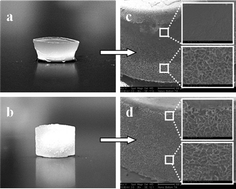Poly(ethylene glycol) cryogels as potential cell scaffolds: effect of polymerization conditions on cryogel microstructure and properties†
Abstract
We report the synthesis and characterization of interconnected macroporous network structures of poly(ethylene glycol) (PEG) using cryogelation techniques. Novel monolithic networks containing a gradient of


 Please wait while we load your content...
Please wait while we load your content...